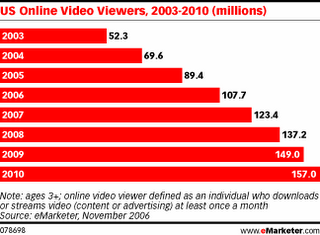
There are many reasons lots of people ought to be paying attention to streaming and downloaded video. Lots of people work for companies making a living delivering video products and everybody watches video in its various forms. Lots of companies are making expensive bets about what people want to watch, how and where they want to watch, what features are required and how much they will watch. The two mid-January developments in the area of particular note are the Netflix "unlimited online viewing" offer and Apple's launch of a video download service.
Up to this point Netflix has allowed its subscribers to watch online movies on a limited basis, corresponding to their monthly plans. Basically, hours of online viewing roughly correlated to the monthly subscription price. The big change is that Netflix now allows users on unlimited rental plans starting at $8.99 a month to stream as many movies and TV episodes as they want on their PCs, choosing from a library of over 6,000 familiar movies and TV episodes.
Now, subscribers on unlimited plans can stream as many movies and TV episodes as they want from the smaller instant watching library, unconstrained by any hourly limits. The move widely is viewed as a preemptive response to Apple's launching of its own video download service, using a rental model rather than "download to own" approach. Up to this point Apple has seen modest success with an approach based on Apple TV hardware and content from two studios, Disney and Paramount.
All major Hollywood studios have agreed to make their content available as part of the new Apple service. They include Paramount, Universal, Walt Disney, Warner Bros, Sony Pictures, Metro-Goldwyn-Mayer, Lionsgate, New Line and News Corp's Fox.
Using Apple's iTunes online store, US consumers will be able to hire new-release movies at $3.99 for 30 days. Older titles are priced at $2.99 for the same duration.
These movies can be viewed on iPhones, iPods and television. One can debate the impact of Apple's more-aggressive move into online downloads and streaming. In fact, one can argue that the streaming business is a different segment from the "download to own" market or the "rent by downloading" segment.
One also can debate who wins and loses in the video rental business: Netflix, Blockbuster, Amazon.com, Joost, iTunes or others. Even the impact on Netflix is debatable. If consumer use of the streaming feature increases, Netflix will pay more money in licensing fees to the studios who own the content. It also will incur more bandwidth charges. On the other hand, Netflix might spend less money on postal charges, shipping and handling of physical DVDs.
Probably more important is the strategic impact: Netflix's ability to retain existing market share as new competitors enter the market.
The other issue is which market is affected. To some extent the "view on PC" segment is where Apple, Netflix and others compete head to head. There are other segments, such as the "watch on my iPod" market, where Netflix and others delivering to the PC do not play.
Also, one might debate whether a subscription service is different from a pay-per-view model. Heavier users arguably will prefer a subscription model. Lighter users might well prefer the "pay as you go" model. Also, there is little question but that mobile, iPod, PC and TV viewing segments will emerge as full-fledged markets at some point, irrespective of the payment model.
Business motivations also are different. Apple sells content at prices as low as possible so it can create a market for its devices. Its market is rNetazors (devices) not razor blades (recurring revenue). Netflix has the opposite business model: it only cares about devices as platforms to sell content on a recurring basis.
To some extent, then, Netflix and iTunes ultimately compete with telco, wireless and cable on-demand programming offerings, in addition to competing with each other to some extent. Netflix and iTunes now are in the video on demand business, not the "DVD rental" business.
Telcos and cable companies investing heavily in broadband access networks play in the linear TV space as well as the on-demand video space. They compete directly with each other and satellite providers. But over time each of the three main linear programming providers also competes in the on-demand entertainment market, especially as such viewing can be supported on TV screens at some point.









